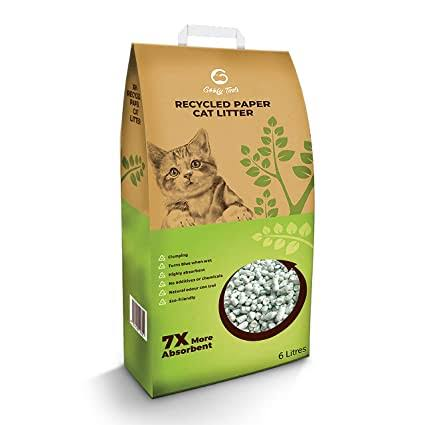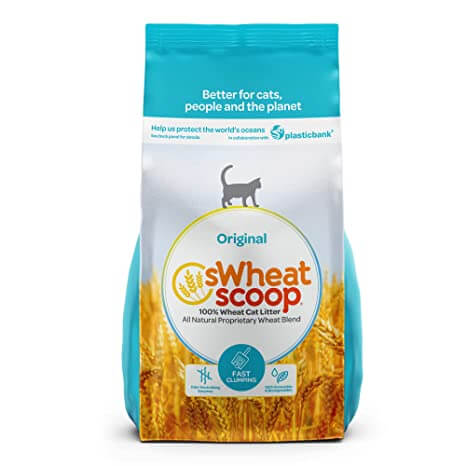Try Best Cat Litter Alternatives
One common ingredient in regular cat litters is clay, often known as sodium bentonite. Clay cat litter is readily available and often reasonably priced, depending on the brand. Conventional clay kibble eventually freezes after absorbing liquids like cat pee. Something loses its ability to contain liquid and usually has an odor when it solidifies. This type of trash is not biodegradable and is detrimental to the environment, hence it should not be used.
Odors must be avoided by changing clay litter on a regular basis. As they become older, cats sometimes try to consume items that aren't food. Taking in clay cat litter can cause dehydration, diarrhea, blockages in the airways, and even death. The expense of treating bentonite toxicosis may be devastating for pet owners.
Most people don't realize how many alternatives are accessible to cat owners. We've put up a list of the top five cat litter alternatives to help you choose the right litter for your feline friend.
1. Paper Litter
Paper is a prevalent kind of natural litter since it is manufactured from recycled resources. Since the pellets won't infect the sutures, it is ideal for cats that have had surgery.
Dust is virtually entirely eliminated by pellets, which is beneficial for cats that have respiratory, ocular, or urinary tract illnesses. If there is no dust, there can be no tracking. It is important to keep in mind that some cats may need some time to adjust to the pellets because they are not accustomed to them.
Because pellets may not clump as effectively as clay, cleaning up after pets may be more challenging. Your cat may smell bad because of the absence of clumping, depending on its natural aroma. Paper litter is usually not flushable, so be careful to check the brand's website before throwing it out.
2. Corn Litter
One type of litter that is made specifically from whole-kernel maize and is called corn litter. Pellets are a wonderful alternative for kittens because of their size. The maize does not feel as soft against your cat's paws as other natural materials do. Some cats may not use their litter box for reasons other than texture. Corn litter is ideal for cat owners and their cats since it is less messy and makes neat clumps. Because of the thick clusters, less food sticks to the sides and bottom of the litter box.
Unlike regular litter, this kind of litter has a distinct fragrance since maize is utilized instead of clay. Some owners don't enjoy this smell, while others think it's better than the scent of their last litter. Corn litter produces dust, therefore it might not be the best choice for cats that have asthma. Certain litters made of maize can be flushed, even if the packaging doesn't say so explicitly. It is important to check the brand's website before flushing trash down the toilet.
3. Coconut Cat Litter
Coconut kitty litter is made entirely of coconut shells. Since it doesn't include any potentially harmful ingredients or allergens, it is hypoallergenic. The coconut formula doesn't smell at first because it doesn't have any aroma. Dust gets tracked because the litter is so fine. It gradually begins to smell because the particles are too tiny to clump together.
Unlike other forms of litter, coconut litter may be disposed of in flower beds, the yard, or even a compost bin. There is no waste produced by this cat litter, thus landfill space is not filled up.
4. Wheat Litter
Wheat litter is a kind of cat litter that is made from "secondary wheat," which is sometimes referred to as grain that isn't good enough to be eaten. The particles feel and look like ordinary clay litter. It is the ideal litter for finicky cats because it isn't very fine or gritty.
Wheat clumps nicely, but it also forms mushy heaps that resemble clay litter. Soft clumps often accumulate on the box's edges and bottom. Some pet owners might find it difficult to clean up after their pets using this Insurance litter.
Odor control is achieved either by the litter's sufficient or effective clump development. It becomes weaker the softer the clusters are. Regular litter changes are necessary to avoid soft masses and unpleasant odors.
When using this litter, dusting and tracking occur since the granules resemble clay litter. Use a vacuum or sweeper every day to remove the wheat crumbs that are scattered around your home. The cat litter substitute that most closely resembles ordinary litter is this one.
Although some wheat litters claim to be flushable, it's advisable to adhere to the instructions on the bag or the manufacturer's website to avoid any septic issues. Wheat is the ideal material for pet owners looking for an eco-friendly product because it decomposes naturally.








